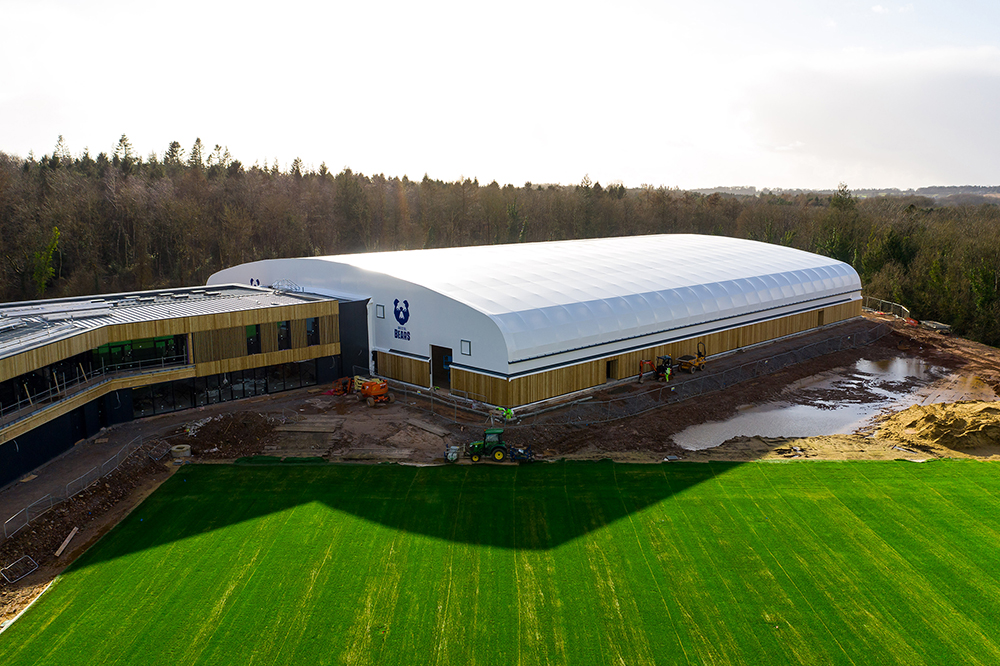The Benefits of Tensile Sports Facilities & Why They’re the Future of Sports Construction

Tensile sports facilities are transforming the way sports venues are designed and built. With their lightweight yet durable structures, fast construction times, and cost-effective benefits, they are quickly becoming the preferred choice for sports halls, stadiums, and multi-use arenas. Whether for football, tennis, or multi-sports centres, these innovative buildings offer unmatched flexibility, sustainability, and performance.
What Are Tensile Sports Facilities?
A tensile sports facility is a lightweight structure made from a durable, tensioned fabric supported by a steel or aluminium frame. These buildings can cover large open spaces without internal columns, making them ideal for sports halls and training centres. Their flexible design allows for custom shapes, faster installation, and energy-efficient operation, making them a modern alternative to traditional sports buildings.
Key Benefits of Tensile Sports Halls & Structures
- Cost-Effective: Tensile fabric buildings require fewer materials than traditional buildings, reducing costs on foundations, labour, and construction time.
- Fast Construction: Prefabricated components allow for quick assembly, meaning facilities can be ready quicker than traditional building construction methods.
- Flexible Design: The adaptable fabric allows for custom shapes and layouts, making it suitable for various sports and multi-purpose uses.
- Natural Lighting & Energy Efficiency: The translucent fabric reduces the need for artificial lighting, lowering energy costs and creating a bright, comfortable atmosphere.
- Durable & Low Maintenance: Designed to withstand harsh weather conditions, tensile sports halls require minimal upkeep over their lifespan.
Tensile vs. Traditional Sports Facilities: Key Differences
When comparing tensile fabric structures to traditional brick-and-mortar sports facilities, several distinctions highlight the advantages of tensile solutions:
- Construction Time: Tensile structures benefit from prefabrication and simpler assembly, leading to faster construction times. Traditional facilities often require longer build periods due to more complex construction processes.
- Cost: The efficient use of materials and reduced labour in tensile construction typically result in lower overall costs compared to conventional buildings.
- Design Versatility: Tensile structures offer greater flexibility in design, allowing for unique architectural expressions and adaptability to various sports. Traditional facilities may face limitations due to rigid construction materials and methods.
- Environmental Impact: The use of sustainable materials and natural lighting in tensile structures contributes to a reduced environmental footprint, whereas traditional facilities might rely more heavily on artificial lighting and non-renewable materials.
How to Choose the Right Tensile Structure for Your Sports Facility
Selecting the appropriate tensile structure involves several considerations:
- Define Your Purpose: Are you building a football training centre, multi-sport hall, or an event space? Choose a design suited to your primary use.
- Assess the Location: Consider weather conditions, available space, and soil type to determine the best materials and structure type.
- Set a Budget: Compare costs for materials, labour, and long-term maintenance to find an affordable yet durable option.
- Look for Customisation Options: Do you need branding elements, seating areas, or a connection to another building? Ensure the structure can be tailored to your needs.
- Check Regulations: Work with experts to ensure compliance with UK building codes, safety standards, and planning permissions.
Common Questions About Tensile Sports Buildings
Are tensile structures suitable for all climates?
Yes, tensile structures are engineered to withstand various weather conditions, including heavy snow, high winds, and intense sunlight. Material selection and structural design are tailored to meet specific climatic challenges.
What is the lifespan of a tensile sports facility?
With proper maintenance, tensile structures can last several decades. The durability of materials like PTFE and PVC contributes to their longevity.
Can tensile structures be relocated?
Although tensile structures can be relocated, due to the fact the pre-fabricated steel frames can be dismantled and moved, the primary purpose of a tensile structure is to provide a permanent building.
How do tensile structures impact energy consumption?
The natural translucency of the fabric membrane reduces reliance on artificial lighting, leading to energy savings. Additionally, the materials used often have insulating properties that contribute to temperature regulation.
What sports can be played in a tensile sports hall?
Tensile sports halls can accommodate football, tennis, basketball, swimming, gymnastics, athletics, and more due to their large, column-free space and flexible design.
How does weather affect tensile sports buildings?
Modern tensile structures are engineered to resist heavy rain, wind, snow, and UV exposure, making them suitable for all climates.
Are tensile sports halls more sustainable than traditional buildings?
Yes. Their lightweight materials, use of natural light, and reduced energy consumption make them a more eco-friendly alternative to traditional sports facilities.
Conclusion
Embracing tensile sports facilities offers a modern, efficient, and versatile solution for sports construction, positioning them as a forward-thinking choice for communities and organisations aiming to enhance their athletic infrastructure.
